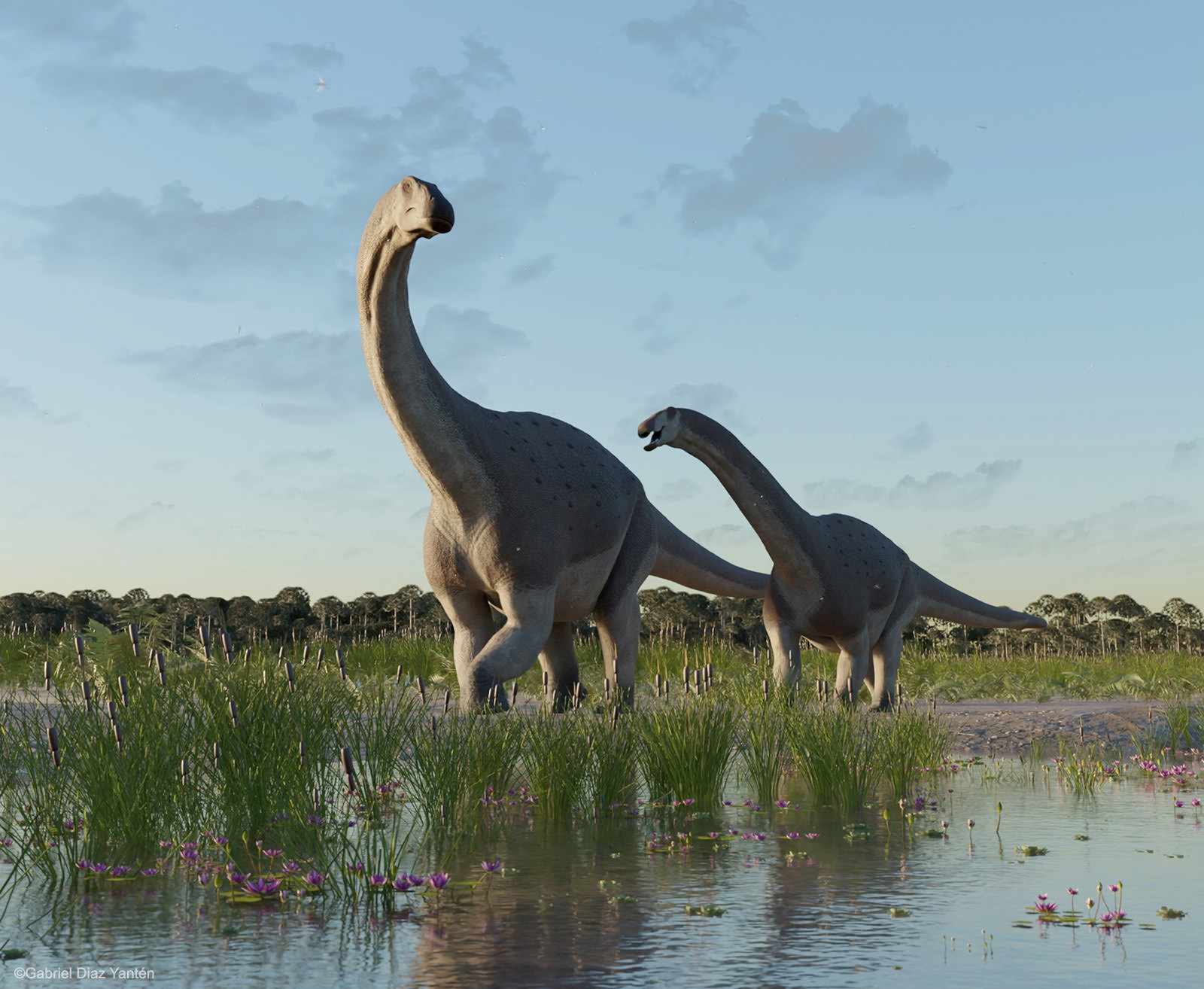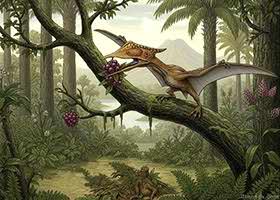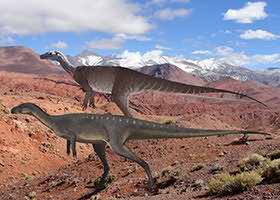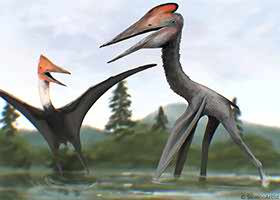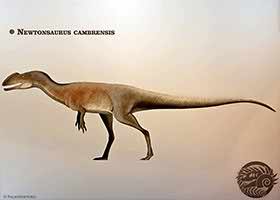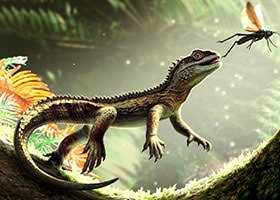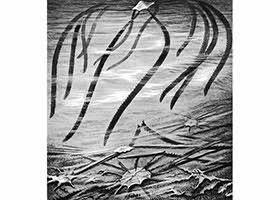
The discovery of early tetrapod trackways redefines the evolutionary timeline, challenging previous notions of the emergence of four-limbed vertebrates. These fossilized footprints serve as crucial evidence of the presence of tetrapods in diverse environments as early as the Early Devonian, approximately 390–400 million years ago. The diversity of these tracks suggests that tetrapods had already achieved widespread geographic distribution by this time.
Scientists have discovered confirmed tetrapod tracks in several locations around the world, including Valentia Island in Ireland, Genoa River in Australia, Tarbat Ness in Scotland, and Zachełmie in Poland. This compels scientists to reconsider the timing and pace of tetrapod evolution.

In general, early tetrapod trackways are quite rare, and researchers have discovered to date only a limited number of limb impressions from the first four-legged animals. However, even among this material, there are questionable findings. At various times, some scientists considered these tracks as belonging to Devonian tetrapods. However, further research has not consistently confirmed or proven this classification. The scientific community now generally accept that these tracks do not come from tetrapods at all. Instead, they may be natural formations, such as erosion patterns, or the result of other animal activity.

Thinopus antiquus, Pennsylvania
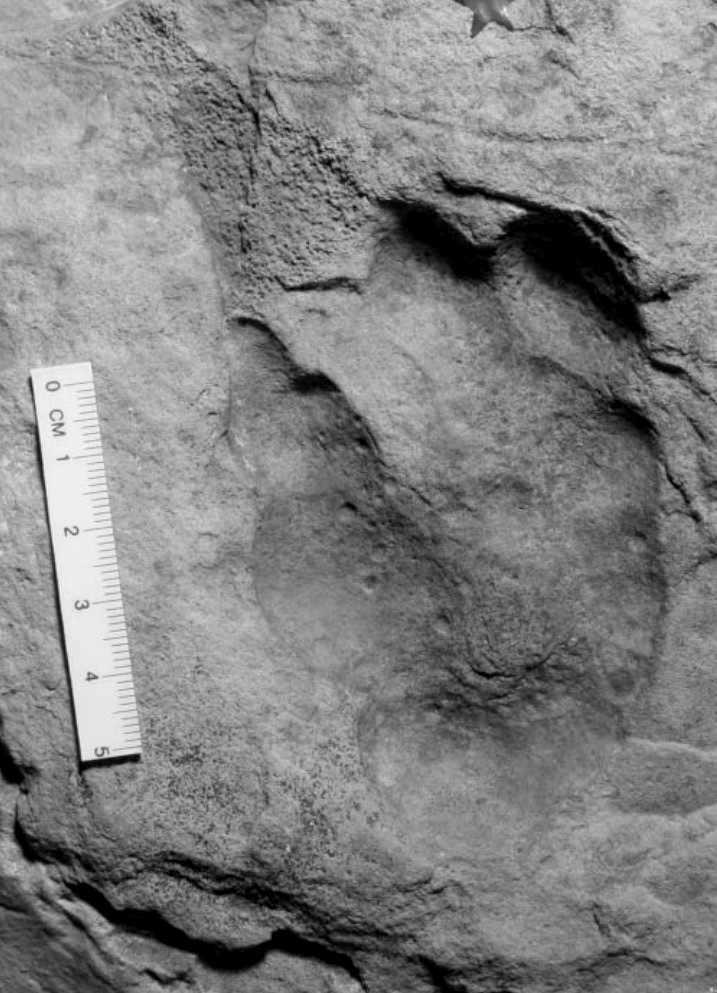
In 1896, Othniel Charles Marsh reported the discovery of “footprints” of the Late Devonian tetrapod Thinopus antiquus. The track comes from Pleasant, Warren County, Pennsylvania. It belongs to the Scherr Formation, previously known as the “Chemung Formation,” dating to the Frasnian age. Paleontologist Charles Emerson Beecher has discovered this fossil print. (Marsh, 1896. Amphibian Footprints from the Devonian)
Beecher noted that the layer with the fossil track also contains ripple marks, mud cracks, raindrop impressions, and marine shellfish, indicating that the footprint formed in a marine coastal environment. Paleontologist found a preserved Nuculana bivalve mollusk on the same fossil slab.

Interpretation of the holotype of Thinopus antiquus with five digits (from Morton, 1926). Overlaying the contours of the skeleton onto the footprint.
Marsh interpreted the fossil as an amphibian track, with a complex impression of two or three toes, which he believed were from the left hind limb.
However, scientists no longer classify this ichnotaxon as a tetrapod track. It has too few toes, and their morphology is incorrect to meet the criteria for early tetrapod trackways. It also lacks symmetry and any other characteristic morphology typical of tetrapod footprints.
Glenisla, Grampians Range, Australia
Glenisla (Glen Isla), Homestead is located in the western region of the Grampians Range, 4.8 km southeast of Mount Bepcha, Australia. The slabs that pave the courtyard here preserve the trackway.
People built Glenisla Homestead using blocks of Grampians Group sandstone deposits that quarriers extracted from Mount Bepcha at the base of the summit and the nearby Glenisla Quarry. The slab containing the tracks came from the Glenisla Quarry.

Warren et al. (1986) described one of these tracks from the Grampians Group in Glenisla, eastern Australia, as a “tetrapod footprint” and interpreted it as the earliest evidence of tetrapod tracks. However, Clack (1997) suggested that an arthropod was more likely to have made this track.
Age of the Trackways
Researchers have debated the age of this track. Some studies suggest it dates to the Early Devonian period (Turner, 1986; Warren, 1991), while others propose a Late Silurian origin (Gourmanis et al., 2003). Despite these differing opinions, Young (2006) confirms that the track is not younger than either of these proposed periods.
Warren et al. (1986) point out issues related to dating this slab, partly due to the uncertainty surrounding the origin of the paving stone, as well as the challenges in dating the Grampians deposits in general.
In earlier studies, dating estimates ranged from the Early Carboniferous to the Late Silurian. Later analyses (Turner, 1986; Milner, 1993) suggested a Givetian or early Frasnian age for the tracks. The most likely age appears to be Early or Middle Devonian, but until further evidence regarding the slab’s origin emerges, the exact date remains uncertain.
Characteristics of the Tracks

The sandstone slab with tracks in the courtyard of Glenisla Homestead preserves straight asymmetrical ripple marks (Warren et al., 1986) and raindrop impressions. The tracks are mostly natural casts and, therefore, appear more as raised features than depressions.
The tracks are quite extensive, although few of them are fully preserved. Most are biserial, with matching tracks on both sides, but in some cases, the tracks exhibit a staggered arrangement.1 All the trackways are straight and represent the same type of behavior, known as repichnia.2
The trackway consists of a ladder-like, rather than alternating, set of poorly defined impressions of varying sizes and shapes. There are no diagonal traces of limb girdles. There is also no sign of overlapping or differentiation between manus and pes.
Warren et al. interpret the sandstone as poorly consolidated, likely based on the lack of clarity in the impressions. However, the original footprints and the grain size of the sediment are not available for further study. Tracks, like those from the Genoa River, often contain coarser sediments. Warren et al. argue that these impressions formed on land rather than underwater because “underwater, poorly consolidated deposits would be unlikely to preserve tracks.”
The Size of the Footprints and the Creature that Made Them

A fragment of a trace scheme. “Staircase gait,” which no tetrapod has ever walked.
The track on the stone is 1.5 meters long and shows no signs of tail or belly drag marks. There are a total of 23 footprints. The width of the pace is 8 cm, the stride is 19.3 cm, and the pace length is 13 cm.
If these are early tetrapod trackways, calculations suggest that the animal was roughly the same size as the one that made the trackway at Genoa River.
The length of the gleno-acetabular region, 290 mm, was estimated by Warren et al. (1986) using a ratio of 1.5 × stride length. The estimated total length of the animal (if it was a tetrapod) would be about 855 mm, based on the Ichthyostega reconstruction by Jarvik (1980).
Interpretation of the Tracks
Milner (1993) recognized this trackway as the earliest tetrapod discovery. George and Blieck (2011) considered the Grampians trackways to be tetrapod tracks made in a marine environment during the Early Devonian, a view echoed by Schultze (2013).
Based partly on the tracks from the Genoa River, some researchers (Panchen, 1977; Janvier, 1977) suggested that tetrapods originated in eastern Gondwana. In contrast, Roček and Rage (1994) questioned whether the track maker in the Grampians was a tetrapod and identified it as a “rhipidistian” track, lacking a median body drag mark.

Glen Isla early tetrapod trackways. (A) The figure shows the Glenisla track as it was depicted in the work of Warren et al. (1986), but the lines showing the presumed angle of the stride have been removed. Thus, the alternation of pes and manus prints becomes much less obvious; rather, the prints on the left side of the track are on average larger than those on the right. Scale bar 100 mm. (B) The figure shows additional details of the prints from a fiberglass replica.
Reevaluation of the Trackmaker
As Clack (1997) noted, this trackway lacks an alternating pattern and instead displays a “ladder-like” pattern, indicative of a symmetrical gait. Additionally, there is no clear differentiation (even in size) between the manus and pes impressions, and the prints themselves are not well-defined. Thus, Clack (1997) expressed skepticism about attributing this trackway to tetrapods.
Indeed, Gourmanis et al. (2003) recently classified the Grampians trackway as arthropod tracks, specifically Diplichnites. They interpreted the depositional environment at the site of the tracks as a non-marine floodplain on a delta. The tracks likely formed subaerially, as indicated in part by associated raindrop impressions.
Lucas believes that the Grampians tracks are not tetrapod tracks, did not form in a marine environment, and date back to the Late Silurian. He argues that these arthropod tracks should not be included in discussions about early tetrapod trackways and the origin of tetrapods.
Other Tracks at Glenisla
Various ichnofossils and arthropod burrows are abundant in the Bepcha and Glenisla quarries.

Fish track, flat-bedded sandstone facies, slab at Glenisla Homestead; pen for scale. Natichnia ethological class.
Five ridges mark the path of a preserved fish track. The total width is 6.5 cm. A fish likely made this track with its fins. In addition to the fish track, the quarries have also yielded numerous other trace fossils, including worm burrows and invertebrate trackways.

Notopus petri, Parana, Brazil

Notopus petri, G. Leonardi, 1983. A gypsum cast. The original specimen (holotype) is kept at the Departamento Nacional de Produçao Mineral, Seçao de Paleontologia, Rio de Janeiro, Praia Vermelha, RJ, Brazil.
Discovery and Initial Identification of Notopus
Leonardi (1983) described a structure discovered by Renato Castro, likely from the Middle (Givetian) or early Late Devonian (early Frasnian) in the deposits of the Ponta Grossa Formation in Tibagi, Paraná State, Brazil.
He identified this single, isolated impression as the track of a left amphibian hand (Ichthyostegalia). The imprint shows a detailed four-toed structure.
Fossils of marine brachiopods, invertebrate traces, and plant fragments were also found in the Ponta Grossa Formation. This suggests that the environment in which the “track” was deposited was a shallow marine setting (Leonardi, 1994). Researchers believe the imprint originated underwater.
Leonardi (1983) named the “track” Notopus petri, making it the second ichnotaxonomic name (after Thinopus antiquus) applied to a presumed Devonian tetrapod track. Milner et al. (1986, 1993) and Stössel (1995) recognized Notopus as a Devonian tetrapod.
Debates and Reinterpretations of Notopus

The isolated nature of this impression raises doubts about its origin and, therefore, its age. Because it’s a natural cast, the circumstances of its formation are uncertain. This specimen does not provide convincing evidence of terrestriality among Devonian tetrapods.
Roček and Rage (1994), however, noted that this track has only four toes, relatively long and curved, which are much smaller and morphologically very different from any known polydactyl feet of Devonian tetrapods. Therefore, Notopus does not meet the criteria for identifying early tetrapod trackways based on its morphology, particularly the shape and number of toes.
Roček and Rage (1994) reinterpreted Notopus as resembling tracks of the fossil sea star Asteriacites, although they hesitated to make a definitive ichnotaxonomic reclassification. Indeed, Notopus differs from Asteriacites, which has thinner, longer, and less curved arm impressions and is much smaller, with a diameter not exceeding ~32 mm. Thus, Notopus could be a fossil ophiuroid, but it is not synonymous with Asteriacites.

Impression of a single tetradactyl footprint (cast), holotype of Notopus petri Leonardi, 1983, from the Ponta Grossa Formation, Sao Domingos Member, of Tibaji, Parana, Brazil. Attributable to Ichthyostegalia. Specimen no. 1417-R, Secao de Paleontologia DNPM, Rio de Janeiro. Scale in cm. Photo courtesy of the same Secao.
As a separate sedimentary structure, the holotype of Notopus, like the isolated holotype of Thinopus, is difficult to confidently assign to any trackmaker. Clack (1997) concluded, “Extreme caution should be exercised when considering this as evidence of a Devonian tetrapod.”
Kap Graah, Greenland

Geographic location (a) and a simplified geological map showing the main outcrop areas of Devonian deposits in East Greenland (b). The exposure areas of the Kap Graah Group on Gunnar Andersson Land are shown in (c). The maps are modified from Hailer (1971).
Friend et al. (1976) illustrated and briefly described two track fossils in the Devonian Kap Graah Group (Frasnian) deposits in central East Greenland. Scientists discovered these two sets of tracks near the Kap Graah Peninsula, about 100 meters below the layer where remains of Bothriolepis, Phyllolepis, and Holoptychius exist.

The tracks are present on the surface of the sandstone as two long, curved trackways of symmetrically arranged impressions without any median marks. The tracks consist of roughly opposing pairs of more or less circular imprints. The track width is about 200 mm, and the distance between each imprint in the longitudinal direction is around 120–140 mm.
Friend et al. (1976) suggested that these trackways “might have been made by early tetrapods,” but concluded, “Their regularity (referring to their symmetry) and lack of overlapping suggest that these tracks were not made by tetrapods.” They resemble tracks of large arthropods, with a track width of up to 20 cm.
Debate and Conclusion on the Trackmaker
There are several possible creators of these tracks. Because the track lacks the overlapping or dragging marks expected from manus and pes impressions, scientists reject the idea that tetrapods made it. While tetrapods are a possibility, the evidence points away from them. Additionally, tetrapod tracks usually alternate rather than appearing in opposing pairs. Researchers also consider the possibility that large arthropods made these tracks. They note similarities between these imprints and those of some arthropods from the Ordovician and Silurian of South Africa.

Arthropod trackways from the Devonian Kap Graah Group in eastern Greenland (after Friend et al., 1979).
Friend et al. (1976) discussed the possibility that arthropods made the tracks but ultimately rejected this idea. They believed that “there are no known fossils of such large arthropods from freshwater deposits of Devonian age.” They proposed the placoderm fish Bothriolepis as the trackmaker, suggesting that it regularly and simultaneously touched the bottom with its pectoral fins while swimming.
If the animal made these tracks underwater, it could have moved using only its front limbs. Otherwise, it would have left traces of its tail or body. However, since it was not possible to establish a connection between the tracks and the mud cracks also present on the bedding plane, there is no external evidence for this. Moreover, such fin tracks are not known in the fossil record.
In fact, Devonian layers actually contain even larger arthropod tracks. Therefore, we can confidently dismiss the Kap Graah tracks as early tetrapod trackways and identify them as arthropod tracks. These tracks likely belong to Diplichnites.
Hoy, Orkney Islands, Scotland

Orkney, or Orkney Islands. Archipelago in the Northern Isles of Scotland. Hoy Island is located in its southwestern part.
Employees of the Geological Survey, while studying the Upper Old Red Sandstone strata on the island of Hoy, Orkney Islands, Scotland, discovered the track between 1927 and 1929. Wilson reported the tracks but apparently did not collect any specimens, and according to Sarjeant, the original fossil has been lost. Today, only a sketch of it remains.
Sarjeant (1974) published an early illustration from Wilson et al. (1935) of the supposed track. He reproduced a drawing of the trackway, the sample of which has long been lost. Some have considered this specimen as a possible early tetrapod trackway from the Late Devonian. Leonardi (1987) also reissued this illustration.
Characteristics of the Tracks
One of the tracks drawn by the discoverers had an overall width of 23 mm. The track consists of a straight central groove, bordered on each side by small, regular spots that are roughly alternating from the left and right sides. The spots sometimes connect with the central strip, and sometimes they do not.
This track suggests that the tetrapod that made it was very small. The track is relatively small compared to other presumed tetrapod footprints.
Various Interpretations of the Tracks

Supposed trackway from the Devonian of Hoy Island, Orkney Islands, Scotland: a belly-drag trace, with the impressions of fin-marks alongside. It appears to be the track of a rhipidistian fish. Old Red Sandstone. External trackway width: about 3 cm. After W.A.S. Sarjeant, 1974, Leonardi, 1987.
The assumption of a tetrapod origin for this track has some basis. Westoll (1937) initially proposed that these impressions could be tetrapod tracks, with the tracks overlapping completely. It doesn’t sound very convincing, though.
Sarjeant (1974) attributed it to a crawling fish resembling a dipnoan.
According to Leonardi (1983, 1987), this fossil from Hoy is more likely a trace of a rhizodont fish rather than a true tetrapod. It resembles a belly track, alongside which are visible traces of fins (or fin-like impressions).
Rogers (1990) suggested that this is a track of an arthropod, resembling Siskemia. However, Siskemia is quite different, especially in that it lacks an impressed central groove (its central pattern consists of two parallel but separated tracks) and does not show any connection between the limb impressions and the central track.
Clack (1997) considered the fossil from Hoy as a trackway and stated that “these tracks may be just what one would expect for a very small Ichthyostega.” However, without a specimen or other similar samples, as well as without knowledge of the context, it is impossible to confidently determine which animal or habitat this track might represent.3
The Hoi Prints are not a Tetrapod
However, considering its symmetry and the connection of the lateral projections to the central track, the Hoy fossil is clearly not a trace of tetrapods or arthropods. In fact, it more closely resembles a plant, possibly a stem of zosterophyll with attached sporangia. Therefore, its identity as a track is questionable. Moreover, it cannot be re-examined. Thus, this finding has no relevance to the records of early tetrapod trackways.
Tumblagooda, Kalbarri, Western Australia

In Kalbarri National Park, there are numerous traces dating to the Silurian or Early Devonian of Australia (McNamara, 2014). None of the researchers has attributed these traces to tetrapods; however, references to them frequently appear in publications about early tetrapod trackways.
The Tumblagooda Sandstone contains many fossilized tracks and burrows belonging to a peculiar ecosystem dominated by arthropods. The deposition of sediments occurred in the Early Ordovician to Silurian. Some researchers believe that the visible traces may represent the earliest evidence of terrestrial animals. However, they do not exhibit diagnostic features of tetrapods.
These traces could only have formed on open, moist sand. The tracks vary in clarity and nature depending on the moisture of the underlying sediments.
The terrestrial traces found in the Tumblagooda Sandstone consist of numerous types of walking traces called Diplichnites. These tracks consist of pairs of parallel rows of “pits” or paddle-like impressions. They can extend across the surface for many meters. Diplichnites tracks are interpreted as traces of arthropods walking across the sediment surface, indicating a diversity of arthropod fauna during sedimentation.
Additionally, there are numerous traces left underwater (subaquatically).
- Gouramanis, Warren and Webb, 2003. Fluviodeltaic sedimentology and ichnology of part of the Silurian Grampians Group, western Victoria. ↩︎
- Repichnia—in ichnology, these are tracks or traces left by organisms during directed movement, rather than during other types of behavior, such as resting or feeding. These traces are typically associated with the movement of organisms across a substrate. Animals can leave distinct traces when walking or crawling over soft sediment surfaces; repichnia are the fossilized impressions of these traces. The same animal may exhibit different movement patterns (e.g., walking, cantering, and galloping). Diplichnites, Cruziana, and Protichnites are prime examples of Repichnia ichnofossils. By studying traces of directed movement, researchers can gain insights into the movement patterns, speed, and orientation of ancient organisms. ↩︎
- J.A. Clack, 1996. Devonian tetrapod trackways and trackmakers; a review of the fossils and footprints. ↩︎




